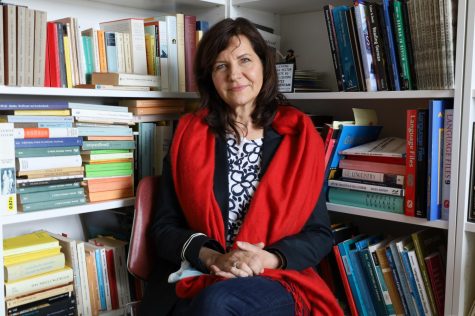



German Professor Volker Langbehn anticipates that the German or Italian program will be discontinued following his retirement in two years.
May 4, 2022
Volker Langbehn joined SF State’s Modern Languages and Literatures department as an assistant professor in 2002, at a period of time when the German program was thriving.
In Fall 2004, Langbehn taught a combined undergraduate and graduate seminar, The Holocaust and Postwar Germany Taught in English, in which he recalled having about 30 students enrolled – a full class.
Much has changed since then. He now heads the German program, one of the smallest in the university.
“The Modern Language Department is an exotic bird, and I’m not so sure if so many students actually know about its existence,” Langbehn said.
The MLL department at SF State has undergone a decrease in majors over the past seven years, including its more popular programs such as Japanese and Spanish. SF State’s Institutional Research unit reported 190 students majored in an MLL program last fall — a decrease of over 37% from Fall 2014 when there were 302 students.
Last fall, the German and Italian master’s programs were discontinued. Langbehn predicts that either the German or Italian major will be discontinued following his retirement in two years since the programs lack student demand.
“Student interest – the number of student majors there is quite low; I would say both programs are vulnerable,” said Andrew Harris, dean of the College of Liberal & Creative Arts.
The German program currently has two full-time faculty members — Professor Ilona Vandergriff and Langbehn. The Italian program has a lecturer and an assistant professor, Carlo Padula and Olivia Albiero, respectively. Alberio, who was hired as an assistant professor in 2016, teaches in both German and Italian.
Langbehn anticipates Albiero will transition to full-time with the German program when he retires, leaving the Italian program with a single lecturer. He said that for a program to be sustainable, it must have at least two full-time faculty members.
“Italian will have a hard go because, by the sheer numbers, we cannot offer the number of courses for students to graduate on time,” Langbehn said.
According to MLL Department Chair Charles Egan, it’s easy to sustain a program as long as there are tenured faculty. When tenured faculty in smaller programs leave, the Academic Senate doesn’t replace them.
Two tenured Russian program faculty retired in 2005. Consequently, the Russian minor, bachelor’s and master’s degree offerings were cut.
The last time tenure-track faculty were hired in the MLL department was during the 2016-17 academic year for the French and German programs.
Harris said the college has advocated for tenure positions for the MLL program since then, but have not been approved; tenure-track lines are allocated based on student demand and there is higher student demand elsewhere in the university.
MLL majors have declined more than the university’s total enrollment, which saw a 9.6% decrease from Fall 2014 to Fall 2021. Students majoring in German decreased from 11 in 2014 to six in 2021. Students majoring in Italian decreased more, from eight students in 2014 to two students last semester.
Since the German and Italian majors are not in high demand, according to Harris, tenure-track lines for the programs are not a priority.
During the 2015-16 school year, Langbehn made efforts to promote the German program and track increased enrollment. He reached out to the School of Engineering — the fourth largest of SF State’s 63 departments — with what he called a “vision paper.”
His detailed, eight-page proposal introduced an international engineering program that would have offered students an opportunity to study abroad and earn units toward two bachelor’s degrees: one in a foreign language and another in engineering. Students would be eligible for internships with companies such as BMW and Volkswagen and potentially attain an engineering position with those companies in the American marketplace.
Multiple universities such as Purdue University, University of Connecticut and UC Irvine already offer international programs, all of which have seen increased student interest and enrollment.
Purdue University’s Global Engineering program reported an 85% increase in participation from 2013 to 2018. According to its Office of Institutional Research, international experiences, like studying abroad, are a key component of transformative education.
Faculty in the MLL department discussed the proposal with the head of the School of Engineering, Timothy D’Orazio. D’Orazio favors language studies as a former study abroad student himself but didn’t see the feasibility of the international program.
“It’s difficult to institute with a high unit major because BAs and BSs are different numbers of units,” Egan said. “And so the engineering program is a very high unit major. So, to be able to do it, it would require a five-year BA instead of a four-year, for example.”
Another attempt was made with the current director of the School of Engineering, Kwok-Siong Teh, in Fall 2018 when Teh first became director. Teh was an international student himself, speaks six languages and studied abroad during his time at the University of Illinois Urbana-Champaign.
After discussion within the department and with the dean of the college, the School of Engineering decided again not to pursue the proposed dual-degree program for similar reasons to D’Orazio. Langbehn disagrees with the reasons not to pursue the dual degree and made it known.
“It is one of those things that I think is beneficial for students if they are interested in picking up the second language, which I hope more students would be interested in, but I think it’s just the nature of what it is on this campus,” Teh said.
Alternatively, Vandergriff suggested implementing a foreign language graduation requirement to increase enrollment, which other faculty in MLL agree with. Part of the CSU’s mission is, “to prepare students for international, multi-cultural society.”

Within the CSU system, five universities have language requirements for undergraduate students to earn a bachelor’s degree: Sacramento State, Cal State San Marcos, San Diego State, Cal State Monterey Bay and Cal State Channel Islands.
The UC system has already implemented foreign language requirements across all of its campuses.
“The university, the CSU, it does not value language learning to the extent that they would make it a requirement,” Vandergriff said. “We know that students, they’re very pragmatic, they know, ‘This is what I need to do in order to complete my education.’”
She added that one of the biggest problems for SF State is graduation rates and timely graduation, which have been lower than the CSU’s average. Much like the proposal of an international engineering program, adding an additional language requirement would keep students in school longer.
“Overall language learning does not have the same value or the same kind of capital it has in other places. In America, there’s often not been enough value assigned to the languages that exist in the community,” Vandergriff said.
Egan said that people need foreign language skills in California to provide basic services across industries such as health, education and government. MLL has started offering cross-disciplinary courses such as Spanish for Health Care Professionals.
Harris sees potential in increasing enrollment by encouraging other departments to adopt a language study as complementary studies to another major.
“There’s no shortage of ways that we can connect, not only to health professions but probably others as well,” Harris said. “I think that’s a real conversation that the Department of Modern Languages has an opportunity to lead because I do think there’s opportunity there.”
The American Council on the Teaching of Foreign Languages conducted a national study in 2019, surveying 1,200 managers and human resources professionals. Nine out of 10 United States employers reported a need for employees who are proficient in languages other than English.
The United States Census Bureau estimates 26.6% of the California population are foreign-born residents, double that of the nation’s 13.5%. Additionally, the Migration Policy Institute reported that as of 2019, 52% of foreign-born residents in California have limited English proficiency, and almost half the population speak a language other than English at home.
“The Italian program has served students and community members for decades, and it has had and continues to have strong ties to cultural institutions here in San Francisco — in the Bay Area overall,” Albiero said in an email. “Small programs tend to be particularly vulnerable at challenging times in higher education, especially when the learning of languages and literature are not a priority.”
SF State sets out a new strategic plan every five years, with its latest adopted in 2015. The Strategic Planning Committee started developing a new plan in September last year.
“Strategic planning provides a university with the opportunity to assess its success, embrace its challenges and engage in continuous work to strengthen itself and better serve its communities,” SF State President Lynn Mahoney wrote in an email last fall.
“I think it’s mostly talk,” Egan said. “The current strategic plan focuses primarily on social justice, which is a wonderful goal, right? But there’s almost no mention of international things in it. Whereas the previous strategic plan was all about internationalization. But even then it was more talk than action.”
The Academic Master Plan Framework currently recommends the new strategic plan “support and develop academic programs that address international and global concerns,” and “internationalize the curriculum and facilitate international exchanges.”
“Well, certainly there’s a contradiction,” Langbehn said. “When an institution such as San Francisco State makes the big spiel that it’s so international, then I wonder out loud, ‘How can you make that claim if ultimately down the line your Department of Modern Languages phases the question of: Can we keep it up?’”

